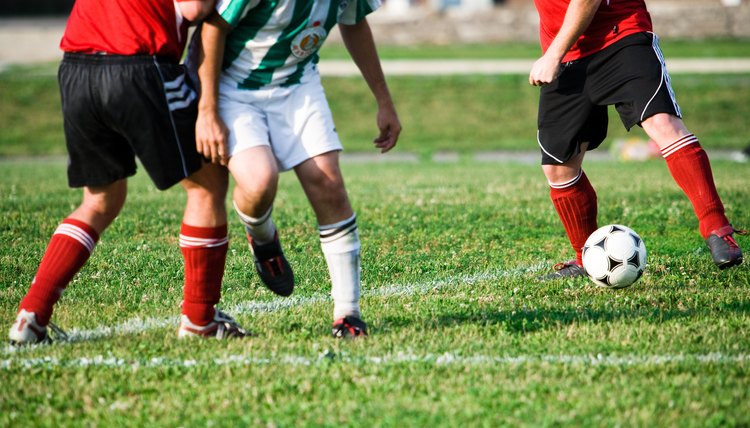How Does Soccer Affect the Body?

Playing a 90-minute game of soccer is an intense experience, and affects your whole body, from your brain to your feet. Playing the sport provides cardiovascular and muscular fitness. The bulk of the work is done by your legs, but you use many other muscles as well. You will also use your head, both physically and mentally, strengthening your mind-body connection. Injuries are also part of the sport; however, proper training can reduce your risk.
Cardiovascular Fitness
One of the most prominent benefits of playing soccer is its ability to improve your cardiovascular fitness level. Cardiovascular fitness is, according to the American Sports Medicine Institute, the efficiency of your heart, lungs and vascular system to deliver oxygen to your muscles to maintain activity. Running involves moving large muscle groups, like your legs, which causes your heart beat and respiration to increase. During a game, the average player runs about seven miles in a mix of short and long sprints as well as periods of jogging. By the time you are able to play for a full game, your body is in excellent cardiovascular shape.
Muscular Strength
In addition to cardiovascular fitness, soccer demands a great deal of muscular strength. Explosive sprints, quick dribbling moves, shielding an opponent and shooting the ball 30 yards away from the goal require strong muscles. Shooting alone uses a variety of muscles, from your feet to your neck. Consistent practice and play will increase your muscular strength. Muscular imbalances, however -- like stronger muscles in the front vs. the back of your thighs -- actually leave you vulnerable to injury. Though running and skill drills are an important part of practice, strength training is equally valuable.
Using Your Head
Soccer also has an impact on your head and brain. Because it requires quick changes of pace and technical agility movements, the connections between your brain and body strengthen. The game is also fluid, meaning there are few set patterns and plays; your brain is constantly computing new strategies and courses of action. Your head is also used to move the ball, which can, unfortunately, lead to concussions. According to a 2010 study published in "Brain Injury," most athletes do not know they have a concussion; they experience symptoms after a game but are often not diagnosed or treated. If the ball hits the wrong part of your head and you feel dizzy, talk to the athletic trainer immediately to rule out concussion.
Injuries
Injuries, which are common in a soccer match, will also impact your body. Bruises, pulls, tears and sprains occur most often in your legs, though they can happen anywhere. Soccer injuries are divided into traumatic and overuse injuries. Competing continuously for months and years leads to tendinitis, shin splints and joint problems. During tournaments, where you may play more than one game per day, you run the risk of pulling muscles from overuse and fatigue. Your upper leg muscles, the hamstrings and quadriceps, are most commonly strained or pulled. Maintaining fitness, stretching and getting enough rest can help prevent injuries.
References
Writer Bio
Christy Callahan has been researching and writing in the integrative health care field for over five years, focusing on neuro-endocrinology. She has a Bachelor of Science degree in biology, earned credits toward a licensure in traditional Chinese medicine and is a certified Pilates and sport yoga instructor.
